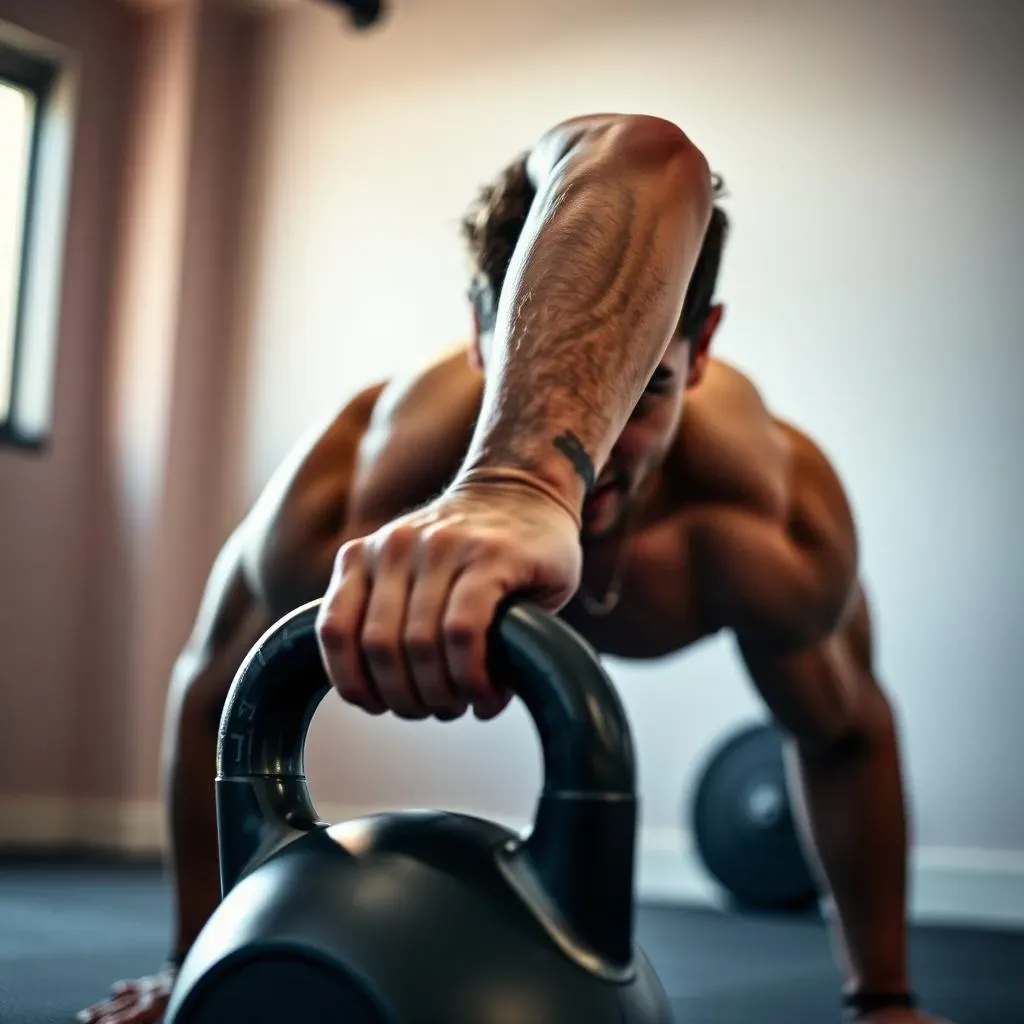Table of Contents
Ready to unlock your fitness potential without fancy equipment or complicated routines? This article reveals the secrets to transforming your body with just one simple tool: the kettlebell. We'll explore the 3 best kettlebell exercises – movements that are surprisingly effective at building strength, improving endurance, and boosting your overall fitness. Forget complicated gym memberships and confusing workout plans; we're focusing on three foundational exercises that deliver incredible results. These aren't just random picks; these are the exercises proven to provide maximum impact with minimal time investment. Get ready to discover how the kettlebell swing, goblet squat, and Turkish get-up can completely change your workout game and sculpt a stronger, more powerful you. Whether you're a seasoned athlete or just starting your fitness journey, this guide will empower you to master these essential moves and achieve your fitness goals. Let's dive in and discover why these are considered the 3 best kettlebell exercises!
The Kettlebell Swing: Building a Powerful Foundation

The Kettlebell Swing: Building a Powerful Foundation
Mastering the Technique
The kettlebell swing isn't about brute strength; it's about harnessing your body's natural power. Think of it like a pendulum—smooth, controlled movement is key. Start with a light kettlebell to get the feel of the swing. Focus on hinging at your hips, keeping your back straight, and driving the kettlebell forward with your legs and glutes. Don't just fling it; feel the power coming from your core. A proper swing engages your entire posterior chain—glutes, hamstrings, and lower back—making it a fantastic full-body exercise.
Many beginners struggle with maintaining a straight back, which can lead to injury. To help avoid this, imagine you're trying to crack a walnut between your glutes at the bottom of the swing. This helps you maintain the correct hip hinge and prevents rounding of the spine. Remember to breathe! Exhale forcefully as you drive the kettlebell upwards, and inhale as you return to the starting position. For more detailed instructions and variations, check out our beginner kettlebell workout guide.
Common Mistake | Correction |
|---|---|
Rounding the back | Focus on hip hinge, engage core |
Using arms to swing | Power comes from legs and hips |
Lack of control | Practice slow, controlled movements |
Building Strength and Power
The beauty of the kettlebell swing lies in its ability to build both strength and power simultaneously. It's a fantastic exercise for improving explosive power, which translates to other activities like sprinting, jumping, and even everyday movements. As you become more proficient, you can increase the weight of your kettlebell or the number of repetitions. Remember to always prioritize proper form over lifting heavier weights. Think of building strength like baking a cake; you need time and patience for the best results. Don't rush the process!
Start with 2-3 sets of 10-15 repetitions, gradually increasing the weight and repetitions as you get stronger. Listen to your body. If you feel any pain, stop immediately and reassess your form. Remember to take rest days to allow your muscles to recover and rebuild. This is crucial for long-term progress and injury prevention. For more advanced variations, explore our kettlebell HIIT workout routine, but only after mastering the basics!
- Start light, focus on form
- Increase weight gradually
- Listen to your body
- Prioritize proper form over weight
Progressing Your Swing
Once you've mastered the basic kettlebell swing, there are numerous variations to challenge yourself and continue building strength. You can try the Russian kettlebell swing, which emphasizes a higher hip drive, or the American kettlebell swing, which involves a fuller range of motion. You can also incorporate the swing into more complex movements, such as the kettlebell snatch or clean and jerk, but only once you’ve established a solid foundation. These are advanced movements and should only be attempted after you have mastered the basics.
Remember that consistency is key. Even a few minutes of practice a couple of times per week can make a significant difference. Don't be discouraged if you don't see results immediately; progress takes time and effort. Celebrate small victories along the way. And if you're ever unsure about your form, don't hesitate to consult a qualified fitness professional. A good trainer can provide personalized guidance and help you avoid injury. For a structured program, check out our beginner kettlebell program for a step-by-step approach.
The Kettlebell Goblet Squat: Sculpting Strength and Stability

The Kettlebell Goblet Squat: Sculpting Strength and Stability
Mastering the Goblet Squat
The goblet squat is your ticket to a stronger lower body. Hold a kettlebell close to your chest, like a goblet (hence the name!). Stand with your feet shoulder-width apart, toes slightly pointed outwards. Now, squat down as if sitting in a chair, keeping your back straight and chest up. Focus on pushing through your heels as you stand back up. It's all about controlled movement and engaging your glutes and quads. Don't let your knees cave inwards – that's a common mistake that can lead to knee pain. For a more detailed guide on kettlebell squats, check out our beginner kettlebell workout.
A lot of people find it tough to get the depth right on a squat. Think about sitting back into the squat, as if you're trying to sit on a low chair. This helps avoid the tendency to just bend at the knees. And remember to breathe! Inhale as you lower, exhale as you rise. Maintaining a straight back is also crucial to prevent injury, so focus on keeping your core engaged throughout the entire movement. For variations and further tips, check out our beginner kettlebell program.
Common Mistake | Correction |
|---|---|
Knees caving inwards | Push knees outwards, engage glutes |
Rounding the back | Engage core, maintain chest up |
Insufficient depth | Sit back as if onto a chair |
Building Lower Body Strength and Stability
The goblet squat is awesome for building overall lower body strength. It works your quads, glutes, hamstrings, and calves all at once – a true full-body exercise, despite its focus on the lower half. It also improves your balance and stability, which is essential for everyday life and other exercises. As you progress, you can increase the weight of your kettlebell or add repetitions. Remember, proper form is more important than weight. A slow and controlled movement is more effective than a fast and sloppy one. Aim for 3 sets of 8-12 repetitions, but adjust based on your fitness level.
Don't forget about the importance of rest and recovery! Your muscles need time to rebuild after a workout. Allow at least one full day of rest between your kettlebell sessions. Proper nutrition also plays a key role in muscle growth and strength gains. Eating a balanced diet, rich in protein and carbohydrates, can significantly improve your results. If you're unsure about your diet, consider consulting a nutritionist. For more ideas on building strength, check out our guide to kettlebell exercises for core strength.
- Focus on controlled movements
- Increase weight gradually
- Prioritize proper form
- Allow for adequate rest
Variations and Progressions
Once you feel comfortable with the basic goblet squat, you can explore variations to keep your workouts challenging and engaging. Try a jump squat for an extra burst of explosive power, or a Bulgarian split squat for improved balance and unilateral strength. You could even add a pause at the bottom of the squat to increase time under tension and build more muscle. Remember to always maintain good form and avoid pushing yourself too hard, especially when trying new exercises.
Remember to listen to your body. If you experience any pain, stop immediately. It's always better to err on the side of caution. If you're unsure about any of these variations, or if you're unsure about your form, consider consulting a qualified fitness professional. They can provide personalized advice and help you avoid injury. Consistency is key – even short, regular sessions will yield better results than sporadic, intense workouts. For a complete program, try our beginner kettlebell program.
The Kettlebell Turkish GetUp: The King of FullBody Exercises

The Kettlebell Turkish GetUp: The King of FullBody Exercises
Mastering the Turkish Get-Up
The Turkish get-up (TGU) isn't your average exercise; it's a full-body movement that challenges your strength, stability, and coordination like nothing else. Think of it as a dynamic flow, taking you from lying on your back to standing tall, all while holding a kettlebell. It's a complex exercise, so start with a light weight to learn the proper technique. Each phase requires concentration and control. Focus on smooth transitions and controlled breathing. Don't rush it. The goal is to feel every muscle working in harmony. For a solid foundation in kettlebell exercises, check out our beginner kettlebell workout.
One of the biggest hurdles for beginners is the transition from lying down to sitting up. Many struggle with maintaining balance and control. To overcome this, practice the individual phases separately before putting it all together. Focus on each movement, ensuring you have a solid understanding before progressing. Engage your core throughout the entire movement, as this will greatly improve your stability and prevent injuries. For a structured approach, try our beginner kettlebell program.
Phase | Focus |
|---|---|
Lie to Sit | Core engagement, controlled movement |
Sit to Kneel | Balance, hip stability |
Kneel to Stand | Leg strength, core stability |
Building Full-Body Strength and Coordination
The TGU is a fantastic exercise for building full-body strength, improving mobility, and enhancing coordination. It challenges your muscles in a way that few other exercises can. Unlike isolation exercises that target only one muscle group, the TGU is a compound movement, meaning it engages multiple muscle groups simultaneously. This is great for building functional strength – the kind that helps you in everyday life, not just in the gym. As you get stronger, you can gradually increase the weight of your kettlebell and the number of repetitions.
Consistency is key when it comes to mastering the TGU. Start with a few repetitions on each side, gradually increasing the number as you get more comfortable with the movement. Remember to listen to your body and take rest days when needed. Your muscles need time to recover and rebuild. Proper nutrition also plays a crucial role in building strength and improving athletic performance. Ensure you're eating a well-balanced diet with plenty of protein and complex carbohydrates. For tips on improving your core strength, check out our 4 kettlebell core exercises.
- Start with a light weight
- Focus on proper form
- Gradually increase weight and reps
- Listen to your body
Variations and Progressions
Once you've mastered the basic TGU, there are many ways to make it more challenging. Try using a heavier kettlebell, or increase the number of repetitions. You can also add variations, such as the TGU with a press at the top, or the TGU with a twist. These variations will challenge your muscles in different ways and help you continue to improve your strength and coordination. Always prioritize proper form over speed or weight.
Remember, the Turkish get-up is a journey, not a race. It takes time and dedication to master this complex movement. Don't get discouraged if you don't see results immediately. Celebrate your progress and keep pushing yourself. If you're ever unsure about your form, or if you experience any pain, consult a qualified fitness professional. They can provide personalized guidance and help you avoid injury. For a complete program designed for beginners, see our beginner kettlebell program.